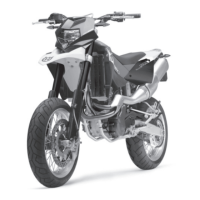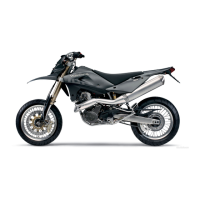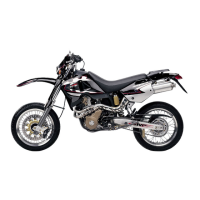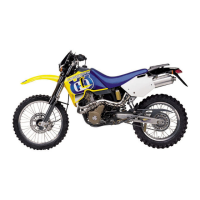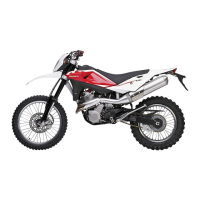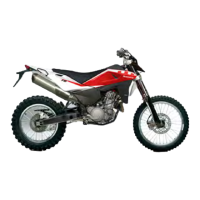Do you have a question about the Husqvarna TE 610 2006 and is the answer not in the manual?
General recommendations for effective repair work and motorcycle maintenance.
Engine specifications including bore, stroke, compression, timing, fuel, lubrication, ignition, and starting.
Details on primary drive, gearbox ratios, and final drive for the transmission system.
Frame construction, steering geometry, suspension travel, and specifications.
Specifications for brake systems, wheel rims, tire types, and cold tire pressure.
Components and specifications for the ignition and electrical systems.
Curb weight and overall dimensions for the motorcycle models.
Fluid capacities for engine oil, cooling system, brakes, and fuel tank.
Checklist of operations for pre-delivery inspection of the motorcycle.
Schedule of routine maintenance tasks at specified intervals.
Troubleshooting guide for engine-related issues like starting, spark, and fuel delivery.
Troubleshooting for frame, wheel, and suspension issues like vibrations and stiffness.
Troubleshooting for electrical system issues like spark plug, charging, and starter motor.
Procedure for checking and adjusting valve clearance and engine compression.
Steps for adjusting the carburetor and setting the correct idle speed.
Detailed steps for draining oil, cleaning filters, and refilling oil.
Procedure for checking coolant level and cleaning the air filter.
How to adjust the throttle cable and clutch slack.
Adjusting front/rear brakes, steering bearings, and fork settings.
Instructions for adjusting front fork damping and rear shock absorber sag.
Steps for adjusting chain tension, alignment, and lubrication.
Introduction to operations related to engine removal and other procedures.
Step-by-step guide to removing the motorcycle saddle and side panels.
Procedure for removing the air filter box and carburetor assembly.
Steps for removing the fuel tank and associated conveyors.
Detailed instructions for removing the exhaust pipes and silencer.
Disconnecting electrical connectors and removing cooling system hoses.
Steps for removing the cooling fan, radiators, and expansion tank.
Detailed procedure for removing the engine from the motorcycle frame.
Instructions for removing the rear frame assembly and fender.
List and identification of special tools required for engine disassembly.
Procedure for removing the gear lever and alternator side cover.
Procedure for removing the alternator and water pump housing.
Steps for removing the cylinder head cover and cylinder.
Instructions for removing valves, piston, and clutch cover.
Procedures for removing starter motor, clutch, and gearbox components.
Steps for separating crankcases and removing crankshaft and gearbox.
Instructions for cleaning engine components with solvent and compressed air.
Checking cylinder head distortion and valve seat condition.
Replacing oversize valves, checking valve guides, and fitting new guides.
Inspecting rocker arms, bushings, and camshaft for wear.
Checking cylinder liner, piston diameter, rings, and clearances.
Checking connecting rod and crankshaft clearances and alignment.
Overhauling clutch components and checking gear selector forks.
Instructions for overhauling, adjusting, and checking the carburetor.
List of special tools required for engine reassembly procedures.
Key instructions and precautions for a correct engine reassembly.
Steps for lubricating and assembling the crankshaft, flywheel, and transmission.
Procedure for assembling the crankcase halves with gearbox and forks.
Steps for reassembling the clutch unit and the oil pump assembly.
Reassembling the alternator cover and performing lay-shaft timing.
Procedure for installing piston rings, piston, and cylinder.
Steps for installing the cylinder head and camshaft.
Key procedures and lubrication points for engine reassembly.
Overview of the Marzocchi USD telescopic hydraulic fork.
General information, fork components, and routine maintenance schedule.
Explanation of how the hydraulic system works during compression and rebound.
Essential rules for disassembling, cleaning, and reassembling fork components.
Common front fork issues like oil leaks, stiffness, and lack of reaction.
Procedure for changing fork oil seals and performing oil changes.
Detailed steps for disassembling and reassembling fork legs and components.
Procedure for bleeding air from the front fork suspension legs.
Adjusting compression and rebound damping rates using external adjusters.
Step-by-step guide to removing the front fork legs from the steering head.
Overview of progressive rear suspension with shock absorber, linkages, and swing arm.
Steps for removing the rear shock absorber assembly.
Detailed procedure for disassembling, overhauling, and reassembling the rear shock absorber.
Procedure for accessing and removing the reservoir plug and valve.
Checking the piston, OR ring, and chrome-plated fork rod surface for damage.
Procedure for replacing the seal gasket on the upper connection.
Adjusting compression and extension damping rates on the shock absorber.
Procedure for removing and overhauling the rear swing arm and axle.
Checking wear of chain components and aligning the chain guide.
Description of the braking system's independent circuits, calipers, and pumps.
Checking brake disc condition, diameter, thickness, and distortion.
Inspecting brake pads for wear and procedures for removal and installation.
Procedure for bleeding air from the front brake system.
Procedure for bleeding air from the rear brake system.
Instructions for changing brake fluid, including precautions and bleeding.
Wiring diagram, key, and location of electrical components.
Components and function of the charging system (alternator, regulator, battery).
Procedures for checking battery current leakage and regulated voltage.
Checking generator stator coil continuity and no-load voltage.
Procedure for checking the voltage regulator-rectifier function.
Components and operation of the starter system, including motor checks.
Overview of the CDI system, energy release, and factors affecting timing.
How to check the primary and secondary winding resistance of the ignition coil.
Information on spark plugs and checking the neutral position sensor.
Procedure for checking the throttle position sensor values.
Battery maintenance, storage, and recharging procedures.
Explanation of digital instrument displays and warning lights.
How to set instrument parameters and reset service reminders.
Instructions for removing and replacing the motorcycle instrument cluster.
Adjusting headlamp beam and replacing headlamp bulbs.
Procedure for accessing and replacing the tail light bulb.
Checking continuity of handlebar switches for proper function.
Guide to routing and securing the wiring harness on the frame.
Troubleshooting guide for electrical system issues.
Procedure for checking the cooling fluid level and potential overheating causes.
Description of the cooling system's components and operation.
Verifying temperatures, checking radiator, electric fan, and pipes.
Description of the forced lubrication system, components, and oil flow.
List and identification of specialized tools for motorcycle maintenance and repair.
Torque specifications for various engine components.
Torque specifications for chassis components like frame and suspension.
Description of frame construction and dimensional checks.
Hub, rim, tire specifications, and cold tire pressure for the front wheel.
Steps for safely removing and reinstalling the front wheel assembly.
Hub, rim, tire specifications, and cold tire pressure for the rear wheel.
Procedure for removing the rear wheel, keeping chain tension.
Checking hub bearing wear, wheel axle bending, and spoke tension.
Checking wheel rim for warpage and sprocket/chain wear.
Procedure for checking chain, pinion, and sprocket wear.
Warning regarding prohibited acts related to noise control systems.
Statement about checking motorcycle noise levels for repairs.
| Engine Type | Single cylinder, 4-stroke |
|---|---|
| Displacement | 576 cc |
| Cooling | Liquid-cooled |
| Transmission | 6-speed |
| Seat Height | 925 mm |
| Ignition | Electronic |
| Final Drive | Chain |
| Front Tire | 90/90-21 |
| Rear Tire | 140/80-18 |
| Ground Clearance | 300 mm |
| Fuel System | Carburetor |
| Rear Brake | Single disc, 240 mm |
| Fuel Capacity | 12 liters |
| Dry Weight | 142 kg / 313 lbs |
| Front Suspension | Marzocchi Upside-down telescopic hydraulic fork with advanced axle, compression and rebound adjustment |
| Rear Suspension | Sachs Progressive Soft Damp system with single hydraulic shock absorber, spring preload adjustment and adjustable rebound damping |

